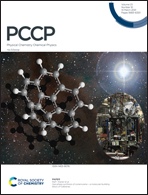Monolayer InSe photodetector with strong anisotropy and surface-bound excitons†
Abstract
The in-plane anisotropy of monolayer InSe plays a critical role in the application of photodetectors. In this work, through nonequilibrium Green's function density functional theory (NEGF-DFT) and time-dependent density functional theory (TD-DFT) calculations, we investigated the anisotropic quantum transport in darkness and under linearly polarized light, and explored the role of surface-bound excitons in the anisotropic photocurrent. The anisotropic dark quantum transport is attributed to different potential barriers in the zigzag and armchair orientations (Id-zig/Id-arm = 1.2 × 102). Linearly polarized photocurrent calculations show that the extinction ratio reaches a maximum value of 105.67. Moreover, surface-bound exciton calculations via TD-DFT revealed that the strong anisotropic photocurrent derives from surface-bound excitons generated in the In 5pz, Se 4pz, and Se 4dz2 orbitals. InSe shows tremendous potential for use in field-effect transistors, flexible nano- and optoelectronics, and polarized light devices.



 Please wait while we load your content...
Please wait while we load your content...